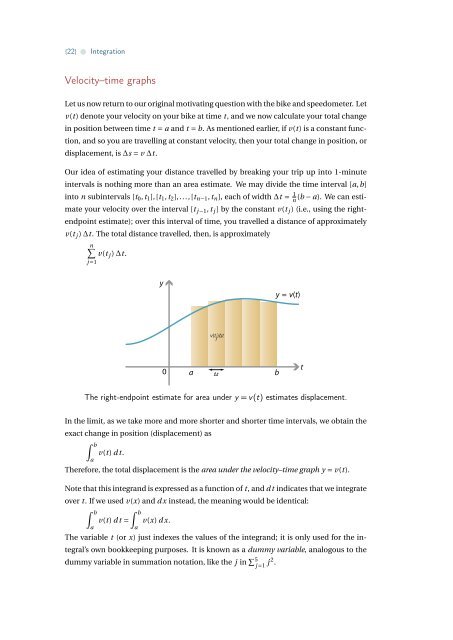Integration - the Australian Mathematical Sciences Institute
Integration - the Australian Mathematical Sciences Institute
Integration - the Australian Mathematical Sciences Institute
You also want an ePaper? Increase the reach of your titles
YUMPU automatically turns print PDFs into web optimized ePapers that Google loves.
{22} • <strong>Integration</strong>Velocity–time graphsLet us now return to our original motivating question with <strong>the</strong> bike and speedometer. Letv(t) denote your velocity on your bike at time t, and we now calculate your total changein position between time t = a and t = b. As mentioned earlier, if v(t) is a constant function,and so you are travelling at constant velocity, <strong>the</strong>n your total change in position, ordisplacement, is ∆s = v ∆t.Our idea of estimating your distance travelled by breaking your trip up into 1-minuteintervals is nothing more than an area estimate. We may divide <strong>the</strong> time interval [a,b]into n subintervals [t 0 , t 1 ],[t 1 , t 2 ],...,[t n−1 , t n ], each of width ∆t = 1 n(b − a). We can estimateyour velocity over <strong>the</strong> interval [t j −1 , t j ] by <strong>the</strong> constant v(t j ) (i.e., using <strong>the</strong> rightendpointestimate); over this interval of time, you travelled a distance of approximatelyv(t j ) ∆t. The total distance travelled, <strong>the</strong>n, is approximatelyn∑v(t j ) ∆t.j =1yy = v(t)v(t j )Δt0a∆tbtThe right-endpoint estimate for area under y = v(t) estimates displacement.In <strong>the</strong> limit, as we take more and more shorter and shorter time intervals, we obtain <strong>the</strong>exact change in position (displacement) as∫ bav(t) d t.Therefore, <strong>the</strong> total displacement is <strong>the</strong> area under <strong>the</strong> velocity–time graph y = v(t).Note that this integrand is expressed as a function of t, and d t indicates that we integrateover t. If we used v(x) and d x instead, <strong>the</strong> meaning would be identical:∫ bav(t) d t =∫ bav(x) d x.The variable t (or x) just indexes <strong>the</strong> values of <strong>the</strong> integrand; it is only used for <strong>the</strong> integral’sown bookkeeping purposes. It is known as a dummy variable, analogous to <strong>the</strong>dummy variable in summation notation, like <strong>the</strong> j in ∑ 5j =1 j 2 .
















